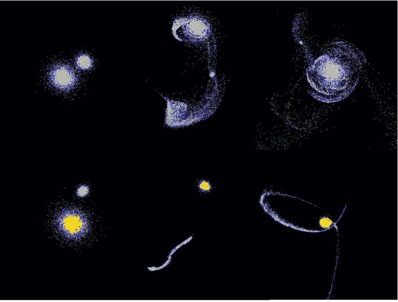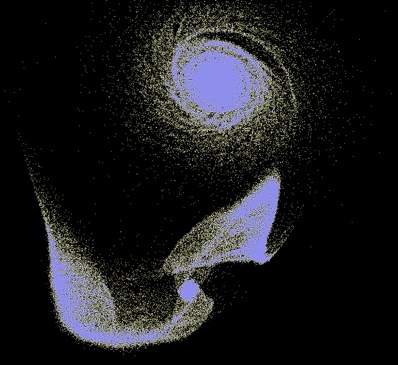
Cosmic dance strips stars from dwarf galaxies
DR EMILY BALDWIN
ASTRONOMY NOW
Posted: July 30, 2009


New computer simulations may provide an explanation for the origin of very small, faint galaxies, the so-called dwarf spheroidal galaxies.
Dwarf galaxies are roughly spheroidal in shape but contain very little gas and stars, and show little evidence for recent star formation. Instead they appear to be made largely of dark matter, an invisible substance that is inferred by its gravitational influence on matter like galaxies, stars, dust and gas. It is the dominating force of dark matter that compacts the dwarf galaxies' sprinkling of stars into a spherical shape.
 In this simulation the top row shows the interaction between a dwarf galaxy orbiting a galaxy with 100 times its mass from time = zero (top left) to time = 2 billion years (top middle) and finally after 7 billion years (top right). The bottom row of graphics show the orbit of the same small galaxy (white) around the Milky Way (yellow) today, which has 10,000 times its mass. Image: Elena D'Onghia (CfA).
In this simulation the top row shows the interaction between a dwarf galaxy orbiting a galaxy with 100 times its mass from time = zero (top left) to time = 2 billion years (top middle) and finally after 7 billion years (top right). The bottom row of graphics show the orbit of the same small galaxy (white) around the Milky Way (yellow) today, which has 10,000 times its mass. Image: Elena D'Onghia (CfA).
Previous theories for the origin of dwarf spheroidal galaxies required them to orbit near large galaxies like the Milky Way, but this did not explain the existence of dwarfs in the outskirts of our Local Group of galaxies.
"These systems are 'elves' of the early Universe, and understanding how they formed is a principal goal of modern cosmology," says Elena D'Onghia of the Harvard-Smithsonian Center for Astrophysics (CfA) and lead author of a paper featured in this week's issue of the journal Nature.
D'Onghia and her team used computer simulations to test two scenarios for the formation of dwarf spheroidal galaxies based on encounters that they might have with other galaxies. In the first scenario an encounter between two dwarf galaxies located far from giant galaxies like the Milky Way was modelled, with the resulting dwarf spheroidal galaxy later accreting into the Milky Way. The second situation modelled an encounter between a dwarf galaxy and a Milky Way-like galaxy forming in the early Universe.
 This simulation screen shot demonstrates the resonant stripping process. Stars from a dwarf galaxy (at the bottom) orbiting around a larger system (top) are stripped away by the gravity of the larger galaxy, teasing out long tails of stars. Image: Elena D'Onghia (CfA).
This simulation screen shot demonstrates the resonant stripping process. Stars from a dwarf galaxy (at the bottom) orbiting around a larger system (top) are stripped away by the gravity of the larger galaxy, teasing out long tails of stars. Image: Elena D'Onghia (CfA).
In both cases the cosmic encounters excited a gravitational dance between the galaxies, which lead to a process coined "resonant stripping." Stars and gas are stripped from the dwarf galaxy, producing long visible tails and bridges of stars, and eventually transforming it into a dwarf spheroidal galaxy.
"This mechanism explains the most important characteristic of dwarf spheroidals, which is that they are dark-matter dominated," says co-author Gurtina Besla. That's because after the majority of star-forming gas has been ripped from the galaxy, all that remains is the dark matter component, along with a handful of stars that were not uprooted during the cosmic dance.
The results of the simulations can be tested with observations. For example, a bridge of stars was recently detected between two nearby dwarf spheroidal galaxies Leo IV and Leo V, which could have resulted from resonant stripping.
|



